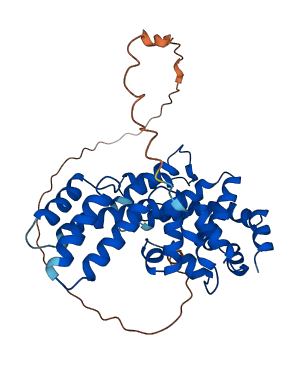Q18312
Gene name |
rgs-3 (C29H12.3) |
Protein name |
Regulator of G-protein signaling rgs-3 |
Names |
|
Species |
Caenorhabditis elegans |
KEGG Pathway |
cel:CELE_C29H12.3 |
EC number |
|
Protein Class |
|

Descriptions
The autoinhibited protein was predicted that may have potential autoinhibitory elements via cis-regPred.
Autoinhibitory domains (AIDs)
Target domain |
|
Relief mechanism |
|
Assay |
cis-regPred |
Accessory elements
No accessory elements
Autoinhibited structure

Activated structure

1 structures for Q18312
| Entry ID | Method | Resolution | Chain | Position | Source |
|---|---|---|---|---|---|
| AF-Q18312-F1 | Predicted | AlphaFoldDB |
No variants for Q18312
| Variant ID(s) | Position | Change | Description | Diseaes Association | Provenance |
|---|---|---|---|---|---|
| No variants for Q18312 | |||||
No associated diseases with Q18312
2 regional properties for Q18312
| Type | Name | Position | InterPro Accession |
|---|---|---|---|
| domain | RGS domain | 112 - 225 | IPR016137-1 |
| domain | RGS domain | 237 - 359 | IPR016137-2 |
No GO annotations of cellular component
| Name | Definition |
|---|---|
| No GO annotations for cellular component |
No GO annotations of molecular function
| Name | Definition |
|---|---|
| No GO annotations for molecular function |
3 GO annotations of biological process
| Name | Definition |
|---|---|
| chemosensory behavior | Behavior that is dependent upon the sensation of chemicals. |
| negative regulation of signal transduction | Any process that stops, prevents, or reduces the frequency, rate or extent of signal transduction. |
| sensory perception of bitter taste | The series of events required to receive a bitter taste stimulus, convert it to a molecular signal, and recognize and characterize the signal. This is a neurological process. |
8 homologous proteins in AiPD
| UniProt AC | Gene Name | Protein Name | Species | Evidence Code |
|---|---|---|---|---|
| O46471 | RGS16 | Regulator of G-protein signaling 16 | Bos taurus (Bovine) | PR |
| Q3T0T8 | RGS5 | Regulator of G-protein signaling 5 | Bos taurus (Bovine) | PR |
| P49802 | RGS7 | Regulator of G-protein signaling 7 | Homo sapiens (Human) | PR |
| O15539 | RGS5 | Regulator of G-protein signaling 5 | Homo sapiens (Human) | PR |
| Q9Z2H1 | Rgs11 | Regulator of G-protein signaling 11 | Mus musculus (Mouse) | PR |
| O54829 | Rgs7 | Regulator of G-protein signaling 7 | Mus musculus (Mouse) | PR |
| Q0QWG9 | Grid2ip | Delphilin | Mus musculus (Mouse) | PR |
| Q8H1F2 | RGS1 | Regulator of G-protein signaling 1 | Arabidopsis thaliana (Mouse-ear cress) | PR |
| 10 | 20 | 30 | 40 | 50 | 60 |
| MWRSYKAETP | ELADETQEVD | LNLHDSSESD | HEGRQSRSAS | ITSSTSAPAS | NDVTLQVPIT |
| 70 | 80 | 90 | 100 | 110 | 120 |
| NSSATSPTPS | TGSMYFIAGM | FDGKEKVNRE | QPPMPTTDGV | EYPRAASWAA | GNCANVLNDD |
| 130 | 140 | 150 | 160 | 170 | 180 |
| KGKQLFRVFL | FQSLAEENLA | FLEAMEKLKK | MKISDEKVAY | AKEILETYQG | SINLSSSSMK |
| 190 | 200 | 210 | 220 | 230 | 240 |
| SLRNAVASET | LDMEEFAPAI | KEVRRLLEND | QFPRFRRSEL | YLEYLEELLP | RSYAEKWAQS |
| 250 | 260 | 270 | 280 | 290 | 300 |
| FEGLLGNHVG | RHHFRIFLRS | IHAEENLRFW | EAVVEFRSSR | HKANAMNNLG | KVILSTYLAE |
| 310 | 320 | 330 | 340 | 350 | 360 |
| GTTNEVFLPF | GVRQVIERRI | QDNQIDITLF | DEAIKHVEQV | LRNDPYVRFL | QSSQYIDLLS |
| KLK |